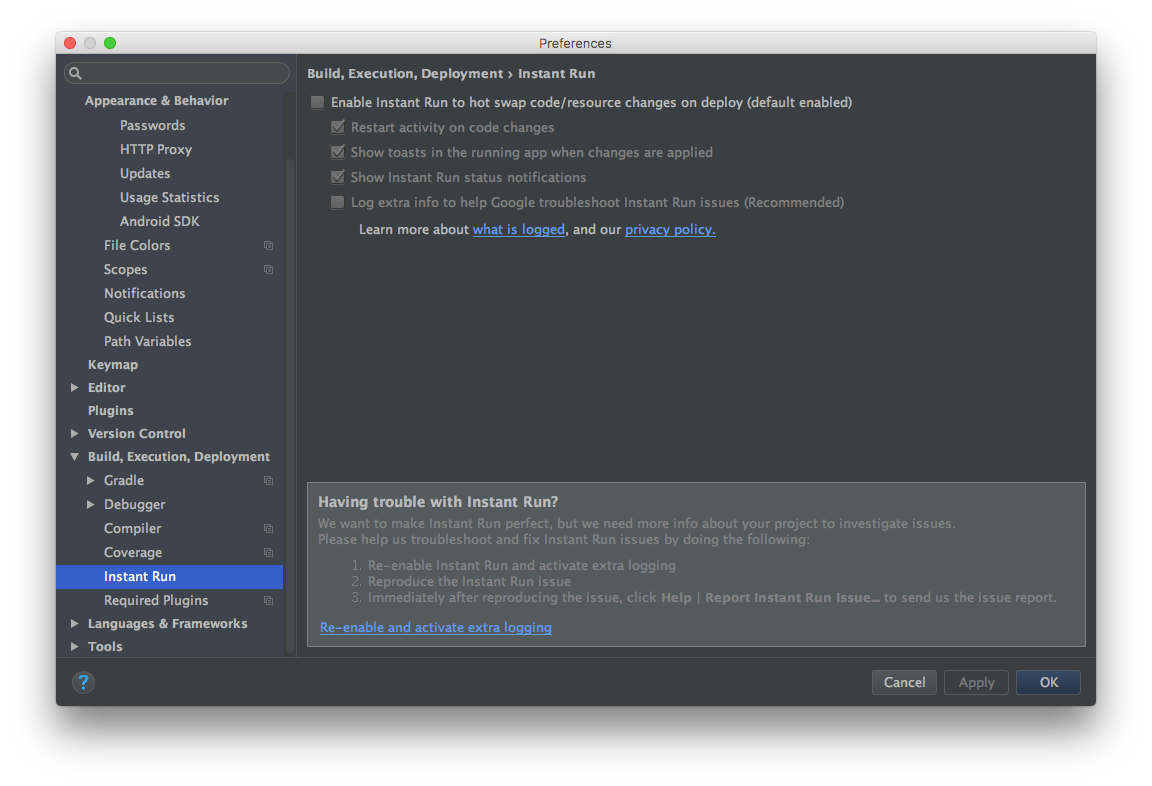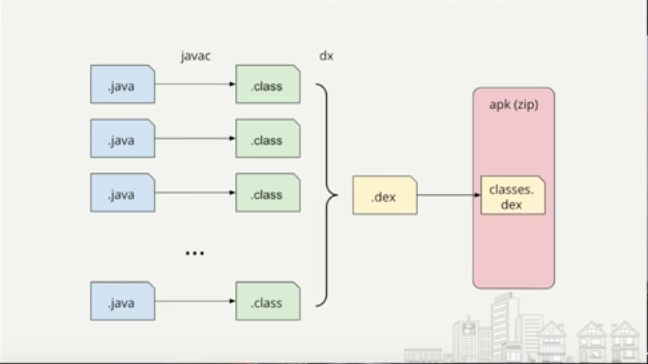This repository hosts an example of dynamically loading an APK and in-depth documentation.
This repo demonstrates how APKs can be loaded into an installed app via ClassLoader. Users can automatically update their application without reinstalling it. Once developers fix any bug or update new features, there is no need to re-build your APK (ClassLoader APK). Developers upload patch APKs to their server.
- Build a ClassLoader APK and patch APK(s).
- Upload the patch APK to your server. Only users who have installed ClassLoader APK can download it.
- Users install ClassLoader APK.
- Users open the ClassLoader app and download the patch APK(s), which include(s) the main business logic of your app.
- Verify patch APK(s) and load classes into the ClassLoader app.
Next, you will repeat the following steps again and again in your development life cycle:
- Add new features or fix bugs
- Build patch APK
- Update the patch APK in your server
- Users open the ClassLoader app to download the patch APK. The app will load all the changes.
To do so, you must create two projects, ClassLoader and patch APK, which combines features and/or layouts.
- Download and validate the patch APK(s) automatically.
- Load classes of the patch APK(s).
- Shrink your app and hide your code in patch APK(s).
- Switch patch APKs. I.e., You can run each patch APK independently without polluting their resources.
- Provide features like instant messaging, taking photos, scanning QR codes, login, or anything.
- UI components and business logic are both supported.
In this demo, ClassLoader app loads Resource1.apk and Resource2.apk.
There are three classLoaders used when running JVM:
- Bootstrap class loader Loads classes from <JAVA_HOME>/jre/lib directory
- Extension class loader Loads classes from <JAVA_HOME>/jre/lib/ext directory
- System class loader Loads classes from the system classpath (which is the same as the environment variable - CLASSPATH).
Besides, you could create your ClassLoader, aka. 'User-defined class loaders'.
Android virtual machine loads classes just like the way Java does, but they're slightly different.
In an Android device, it packages your classes into one or more dex files located in an APK and optimizes those dex files loading with Dalvik.
(screenshot from https://youtu.be/skmOBriQ28E)
(screenshot from https://youtu.be/skmOBriQ28E)
Here are class loaders works on Android:
| Class Loader | Summary |
|---|---|
| BootClassLoader | The top parent of the following classLoaders. |
| PathClassLoader | Load classes located in data/app/... where your app installed. Android uses this class for its system class loader and its application class loader(s). |
| DexClassLoader | Load classes from .jar and .apk files containing a classes.dex entry. This can be used to execute code not installed as part of an application. |
| URLClassLoader | @hide This class loader is used to load classes and resources from a search path of URLs referring to both JAR files and directories. |
First, assume focus on PathClassLoader and DexClassLoader. They both extend BaseDexClassLoader.
In PathClassLoader.class
// set up optimizedDirectory to null to use the default system directory
public PathClassLoader(String dexPath, String libraryPath,
ClassLoader parent) {
super(dexPath, null, libraryPath, parent);
}In DexClassLoader.class
public DexClassLoader(String dexPath, String optimizedDirectory,
String libraryPath, ClassLoader parent) {
super(dexPath, new File(optimizedDirectory), libraryPath, parent);
}It is noticeable that:
- The optimizedDirectory references to optimize dex files.
- PathClassLoader does not accept the optimizedDirectory argument, so it is forced to associate the original, optimized dex files.
- You can pass the optimizedDirectory argument to DexClassLoader(). I.e., you can cache optimized dex files placed in internal storage.
That's why you can call DexClassLoader to load the user-defined APK, dexes, and .jar files, whereas PathClassLoader is responsible for loading the installed Apk.
The code snippet shows how ClassLoader works:
package java.lang;
public abstract class ClassLoader {
public Class<?> loadClass(String name) throws ClassNotFoundException {
return loadClass(name, false);
}
protected Class<?> loadClass(String name, boolean resolve)
throws ClassNotFoundException
{
// First, check if the class has already been loaded
Class c = findLoadedClass(name);
if (c == null) {
long t0 = System.nanoTime();
try {
if (parent != null) {
c = parent.loadClass(name, false);
} else {
c = findBootstrapClassOrNull(name);
}
} catch (ClassNotFoundException e) {
// ClassNotFoundException thrown if class not found
// from the non-null parent class loader
}
if (c == null) {
// If still not found, then invoke findClass in order
// to find the class.
long t1 = System.nanoTime();
c = findClass(name);
}
}
return c;
}
}It shows three steps to load a class.
Step1, check if the class has already been loaded
findLoadedClass(name);Step2, when the class is not found, check if the class has already been loaded with the parent.
if (parent != null) {
c = parent.loadClass(name, false);
} else {
c = findBootstrapClassOrNull(name);
}Step3, if still not found, then invoke findClass to find the class.
findClass(name);The preceding code snippet presents that once a class has been loaded, it'll never be load again.
Play with some scenarios of class loaders.
@Override
protected void onCreate(Bundle savedInstanceState) {
super.onCreate(savedInstanceState);
setContentView(R.layout.activity_main);
Log.i(TAG, "Load core java libraries with " + String.class.getClassLoader());
Log.i(TAG, "Load user-defined classes with " + MainActivity.class.getClassLoader());
Log.i(TAG, "Load user-defined libraries with " + AppCompatActivity.class.getClassLoader()); // what you imports from gradle or libs/
Log.i(TAG, "Default classLoader is " + getClassLoader());
Log.i(TAG, "Default system classLoader is \"" + ClassLoader.getSystemClassLoader());
}| Class Loader | Methods |
|---|---|
| BootClassLoader | String.class.getClassLoader() |
| PathClassLoader[[DexPathList[[directory... | MainActivity.class.getClassLoader() AppCompatActivity.class.getClassLoader() ClassLoader.getSystemClassLoader() |
| PathClassLoader[DexPathList[[zip file... | getClassLoader() |
- User-defined classes and libraries are loaded via PathClassLoader.
- Core java libraries such as
java.lang.Stringare loaded via BootClassLoader. Thus, you cannot create a String class and replacejava.lang.Stringno matter they share the same package name and class name. Android believes that they are two different classes because they are from different class loaders.
In Java, object A equates to Object B when they share the same package name, class name, and ClassLoader
- This app is used to load classes from another APK. You can launch activities or call methods wrapped in another APK. That's why there is nothing but updating loading and verifying APKs in this app.
- Use
getClassLoader().loadClass()to get activities from another APK, and access methods or fields by using Java reflection.
Here are some reflection examples:
Assume Utils is the latest released feature. It will be loaded to your ClassLoader app.
package com.catherine.resource1;
public class Utils {
public static String myStaticField = "Default field";
public static String getInputStringStatic(String value) {
return value;
}
public static int getInputIntStatic(Integer value) {
return value;
}
public static String getStringValueStatic() {
return "(static) Hello from APK1";
}
public static int getIntValueStatic() {
return 1234;
}
public String getStringValue() {
return "Hello from APK1";
}
public int getIntValue() {
return 4321;
}
}However, you cannot find the Utils class in your ClassLoader app. You cannot import it like any other classes as usual. You will need to leverage Java reflection to access it.
- Find the class
private Class<?> apkUtils;
try {
apkUtils = getClassLoader().loadClass("com.catherine.resource1.Utils");
} catch (ClassNotFoundException e) {
e.printStackTrace();
}- Access methods
try {
//set null as the first parameter of invoke() while invoking a static method.
//static String getInputStringStatic(String value)
Method getInputStringStatic = apkUtils.getDeclaredMethod("getInputStringStatic", String.class);
String returns1 = (String) getInputStringStatic.invoke(null, "Hello from your classLoader");
Log.d("Reflection" , returns1);
//static int getInputIntStatic(Integer value)
Method getInputIntStatic = apkUtils.getDeclaredMethod("getInputIntStatic", Integer.class);
int returns2 = (Integer) getInputIntStatic.invoke(null, 86400);
Log.d("Reflection" , returns2 + "");
//static String getStringValueStatic()
Method getStringValueStatic = apkUtils.getDeclaredMethod("getStringValueStatic");
String returns3 = (String) getStringValueStatic.invoke(null);
Log.d("Reflection" , returns3);
//static int getIntValueStatic()
Method getIntValueStatic = apkUtils.getDeclaredMethod("getIntValueStatic");
int returns4 = (Integer) getIntValueStatic.invoke(null);
Log.d("Reflection" , returns4 + "");
//Get constructor for not-static method
Constructor<?> cons = apkUtils.getConstructor();
//String getStringValue()
Method getStringValue = apkUtils.getDeclaredMethod("getStringValue");
String returns5 = (String) getStringValue.invoke(cons.newInstance());
Log.d("Reflection" , returns5);
//int getIntValue()
Method getIntValue = apkUtils.getDeclaredMethod("getIntValue");
int returns6 = (Integer) getIntValue.invoke(cons.newInstance());
Log.d("Reflection" , returns6 + "");
} catch (NoSuchMethodException e) {
e.printStackTrace();
} catch (InvocationTargetException e) {
e.printStackTrace();
} catch (IllegalAccessException e) {
e.printStackTrace();
} catch (InstantiationException e) {
e.printStackTrace();
} catch (NullPointerException e) {
e.printStackTrace();
}- You can access fields as well
try {
apkUtils = getClassLoader().loadClass("com.catherine.resource1.Utils");
} catch (ClassNotFoundException e) {
e.printStackTrace();
}
try {
Field myStaticField = apkUtils.getDeclaredField("myStaticField");
Log.d("Reflection" , myStaticField.getName() + ":\t" + myStaticField.get(null));
myStaticField.setAccessible(true);//You can update the field.
myStaticField.set(null, "new value");
myStaticField.setAccessible(false);
Log.d("Reflection" , myStaticField.getName() + " updated:\t" + myStaticField.get(null));
} catch (NullPointerException e) {
e.printStackTrace();
} catch (NoSuchFieldException e) {
e.printStackTrace();
}- Or maybe you don't want to use any methods or fields. You launch the activity
try {
Class<?> apkActivity = getClassLoader().loadClass("com.catherine.resource1.MainActivity");
Intent intent = new Intent();
intent.setClass(MainActivity.this, apkActivity);
startActivity(intent);
} catch (ClassNotFoundException e) {
e.printStackTrace();
}Read the instructions carefully to make sure your app works properly.
- Update Android Studio Settings
Disabled Instant Run when running classLoader application

- Place patch Apks in advance
Resources path: Android/data/package/files/xxx.apk
- Disable Multidex
In build.gradle
multiDexEnabled false- Register patch APK's activities and permissions in ClassLoader app's Manifest
Android studio probably throws some errors likes 'Unresolved package...', ignore them. And don't forget to add the prefix of your activity name with its package.
E.g.
<activity android:name="com.catherine.resource1.MainActivity" />
<activity android:name="com.catherine.resource2.MainActivity" />- Load layouts
In your patch APK, you cannot map the view by calling setContentView(@LayoutRes int layoutResID). Your ClassLoader app cannot find your resources via that method. You must use View.inflate(). Because applications access resources via Resource, they cannot refer to new resources in the original Resource object.
E.g.
Do not use this:
setContentView(R.layout.activity_main);Instead, replace it with:
setContentView(View.inflate(getApplicationContext(), R.layout.activity_main, null));- How many patch APKs should I load?
Typically, you don't need to load multiple patch APKs. Multiple patch APKs might cause resource conflicts.
Assuming you import the support-v4 library in both APK1 and APK2, and then you load APK1 first, you will load APK2.
You will find your ClassLoader app crashes or some resource errors happens. To fix it, you must have APK2 run on another process so that you can perfectly release loaded resources by terminating the process before you switch to another patch APK.
@Override
protected void onDestroy() {
Process.killProcess(Process.myPid());
super.onDestroy();
}- Android 动态加载基础 ClassLoader 工作机制
- Understanding and Experimenting with MultiDex
- Android ClassLoader 机制
Copyright 2017 Catherine Chen (https://github.com/Catherine22)
Licensed under the Apache License, Version 2.0 (the "License"); you may not
use this file except in compliance with the License. You may obtain a copy of
the License at
http://www.apache.org/licenses/LICENSE-2.0
Unless required by applicable law or agreed to in writing, software
distributed under the License is distributed on an "AS IS" BASIS, WITHOUT
WARRANTIES OR CONDITIONS OF ANY KIND, either express or implied. See the
License for the specific language governing permissions and limitations under
the License.

